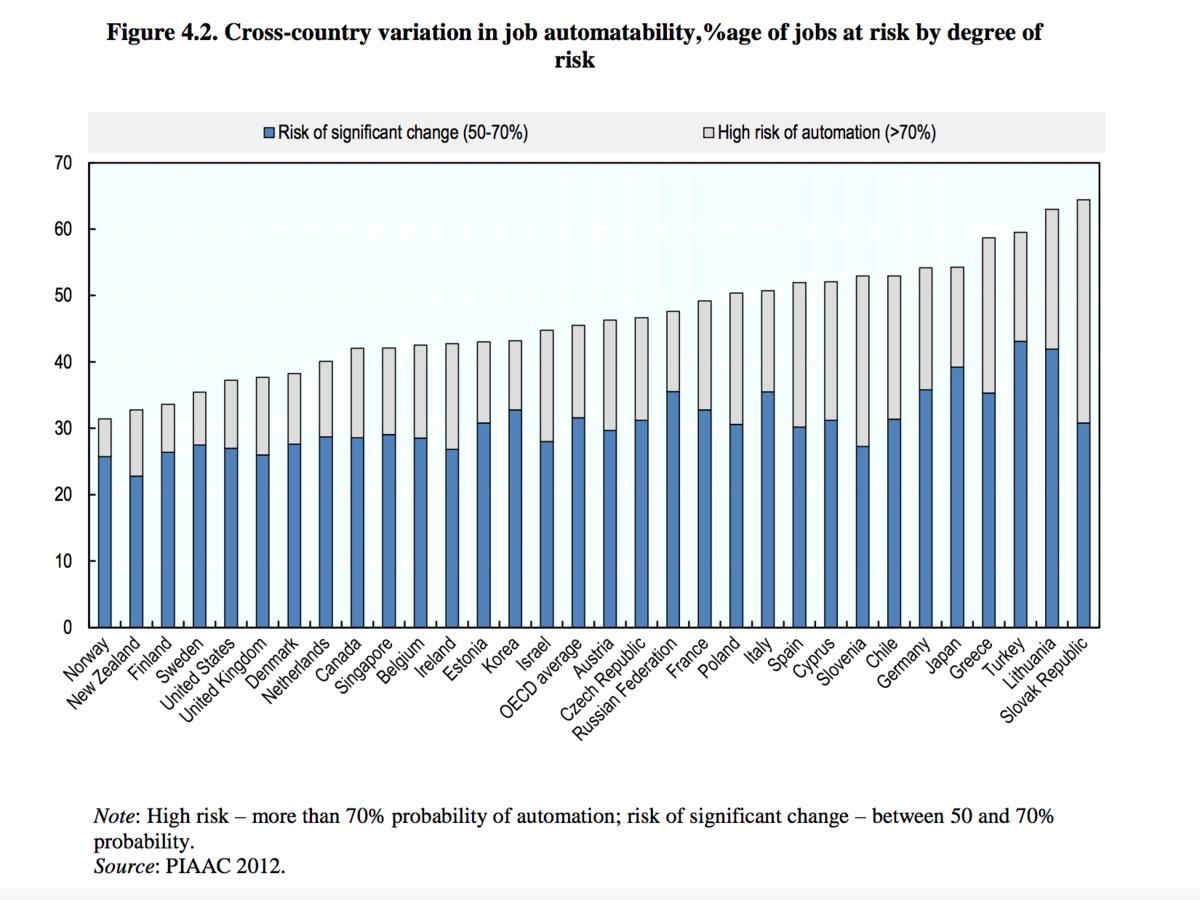自动化取代传统职业之势不可逆,哪些国家抗风险能力更强?
|
自动化或将导致成百上千万的工作消失,但有些国家的就业市场却具备较强的抵御机器人冲击的能力。 以上结论是基于经济合作与发展组织(OECD)的一项研究而做出的。经合组织是世界三十多个富裕国家的政府间国际组织。该组织运用了32个成员国2012年的数据,来评估不同国家就业市场抵御自动化冲击的能力。 研究人员卢比卡·内德科斯加和格兰达·奎恩蒂尼写道:“各国的自动化发展水平存在较大差异。总的来说,与东欧、南欧、德国、智利和日本等国相比,盎格鲁撒克逊地区、北欧国家和荷兰的工作岗位可自动化程度较低。” 研究人员发现,在斯洛伐克的所有就业岗位中,有33%是可高度自动化的。所谓可高度自动化,就是说这些工作至少有70%以上的可能性被自动化取代。这个比例在斯洛文尼亚是25%,在希腊是23%。 而在经合组织国家中,挪威的就业岗位可被自动化的比例最低,只有6%的就业岗位可被高度自动化,其次是芬兰(7%)和瑞典(8%),均低于经合组织32个成员国14%的平均水平。 那么美国的情况如何呢? 研究人员表示,美国约有10%的工作面临被自动化取代的风险。另外,自动化也会造成其他一些工作岗位的重大变革。但总体来说,美国仍然是经合组织中受自动化影响最低的国家之一。不过美国仍有40%的工作存在较高的被自动化取代的风险或发生重大变革的风险,因而自动化的威胁即便在美国,也是一个异常严峻的挑战。 |
Automation may render millions of jobs obsolete—but some countries may be in a better position to face the robots than others. That’s based on research from the Organization for Economic Cooperation and Development, a symposium of largely wealthier nations, using 2012 data from 32 of its members to gauge the risk of job automation on different countries. “The variance in automatability across countries is large,” the researchers Ljubica Nedelkoska and Glenda Quintini wrote. “More generally, jobs in Anglo-Saxon, Nordic countries and the Netherlands are less automatable than jobs in Eastern European countries, South European countries, Germany, Chile and Japan.” At one end of the spectrum, the researchers found that 33% of all jobs in Slovakia are considered highly automatable—or having a 70% or more chance of being automated. That’s followed by 25% of the jobs in Slovenia, and 23% of the jobs in Greece. Norway, on the other hand, is the best positioned. About 6% of jobs in the Scandinavian nation are rated as highly automatable, followed by 7% in Finland, and 8% in Sweden. That’s compared to 14% of jobs across the 32 nations researched. So where does the United States stand? About 10% of jobs in the U.S. are at high risk, the researchers found. When adding in jobs that are also at risk of changing significantly due to automation, the U.S. will be considered among the least affected in OECD countries. Though, with nearly 40% of jobs in the country either with a high risk of automation or risk of significant change, the magnitude of the shift is daunting nonetheless. |

|
不过这份研究的结论还是要比此前的一些分析更加乐观。牛津大学2013年曾做过一份被多次引用的研究,该研究指出,美国有47%的工作有较高的被自动化取代的风险。 不过在经合组织的这份研究中,依然能看到一些相同的趋势,比如最容易被取代的工作仍是那些仅需要较低的教育水平和较低薪酬的工作,如制造业和农业工作等。从事这些工作的往往是青少年。 研究人员还警告道: “在解读与自动化风险有关的数据时,必须注意的是,自动化的真实风险是很容易受到变量影响的,排在国家排行榜前列和末尾的国家虽然排名相对固定,但处于中游或平均水平的国家却相对存在更大的不确定性。”(财富中文网) 译者:朴成奎 |
Still, the research is perhaps more optimistic than some that have come before it. A highly-cited Oxford University study from 2013 found that 47% of jobs in the U.S. are considered highly automatable. Though some trends remain the same: the jobs considered most automatable are those that require low levels of education and are often low paying. That includes positions in the manufacturing industry or agriculture industry. Those positions are also often those occupied by teenagers. But the researchers also added a caveat. “Caution is needed when interpreting the numbers related to the risk of automation: the actual risk of automation is subject to significant variation and, while country rankings at the top and the bottom of the scale are robust to methodological changes, there is more uncertainty for countries closer to the cross-country average,” they cautioned. |













